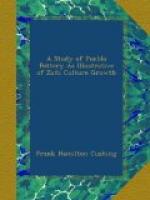[Illustration: FIG. 519—Cooking-pot
of corrugated ware, showing
modified
projections near rim.]
[Illustration: FIG. 520.—Wicker water-bottle,
showing double loops for
suspension.]
Other very important types of vessels were made in a similar way. I refer especially to canteens and water-bottles. The water-bottle of wicker differed little from the boiling-basket. It was generally rounder-bodied, longer and narrower necked, and provided at one side near the shoulders or rim with two loops of hair or strong fiber, usually braided. (See Fig. 520.) The ends of the burden-strap passed through these loops made suspension of the vessel easy, or when the latter was used simply as a receptacle, the pair of loops served as a handle. Sometimes these basket-bottles were strengthened at the bottom with rawhide or buckskin, stuck on with gum. When, in the evolution of the pitcher, this type of basket was reproduced in clay, not only was the general form preserved, but also the details above described. That is, without reference to usefulness—in fact at no small expense of trouble—the handles were almost always made double (see Fig. 521); indeed, often braided, although of clay. Frequently, especially as time went on, the bottoms were left plain, as if to simulate the smooth skin-bottoming of the basket-bottles. (See Fig. 522.) At first it seems odd that with all these points of similarity the two kinds of water-vessel should have totally dissimilar names; the basket-bottle being known as the k’ia pu k’ia tom me, from k’ia pu kia, “for carrying or placing water in,” and tom me; the handled earthen receptacle, as the i mush ton ne. Yet when we consider that the latter was designed not for transporting water, for which it was less suited than the former, but for holding it, for which it was even preferable, the discrepancy is explained, since the name i mush ton ne is from i’ mu, to sit, and tom me, a tube. This indicates, too, why the basket-bottle was not displaced by the earthen bottle. While the former continued in use for bringing water from a distance, the latter was employed for storing it. As the fragile earthen vessels were much more readily made and less liable to become tainted, they were exclusively used as receptacles, removing the necessity of the tedious manufacture of a large number of the basket-bottles. Again, as the pitcher was thus used exclusively as a receptacle, to be set aside in household or camp, the name i’ mush ton ne sufficed without the interpolation te—“earthenware”—to distinguish it as of terra cotta, instead of osiery.
[Illustration: FIG. 521.—Water-bottle
of corrugated ware, showing
double
handle.]
[Illustration: FIG. 522.—Water-bottle
of corrugated ware, showing
plain
bottom.]




